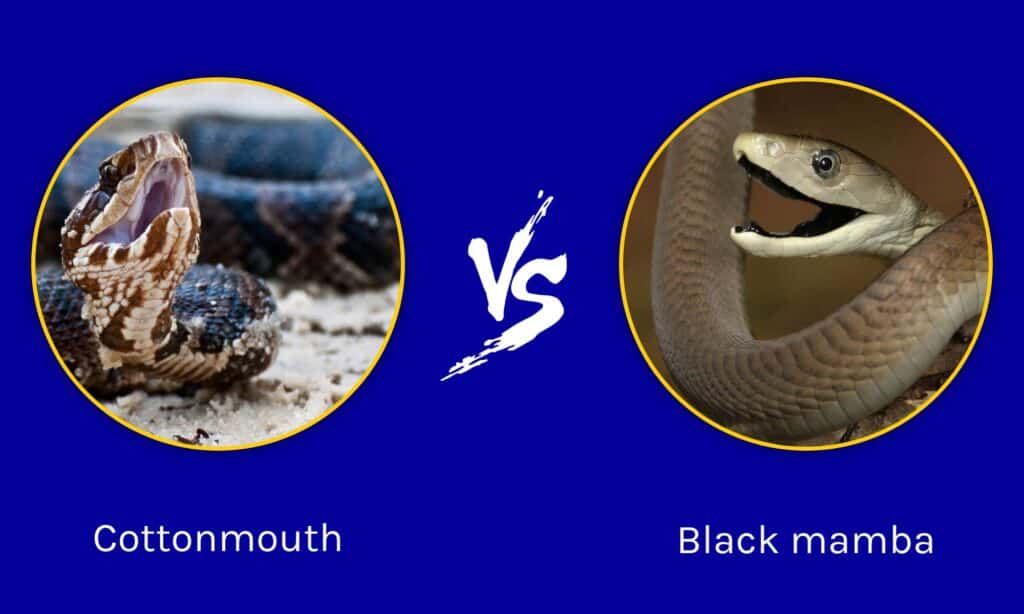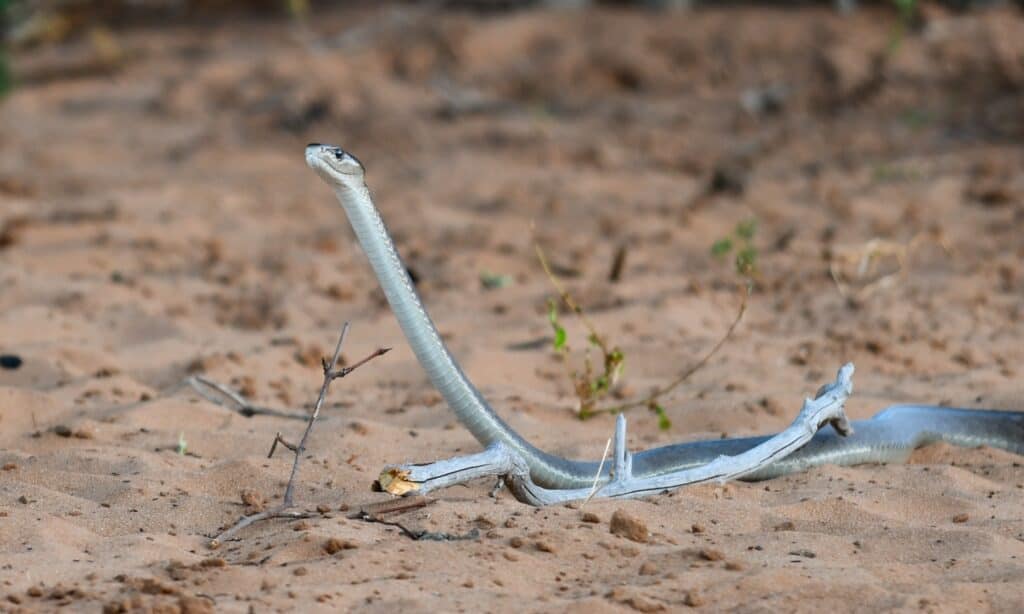For non-experts, all species of snakes are terrifying. Of all the 4,000 species of snakes in the world, only about 600 of them are venomous. And of the 600 venomous species, only 200, or about 7%, are considered deadly or capable of inflicting serious and lethal wounds to humans.
If you live in New Zealand, Iceland, Ireland, and Greenland or are currently on a mission in Antarctica, you’re in luck because there is zero chance that you’ll encounter one of these snakes. But for the remaining countries not mentioned above, chances are high that you’ll come face to face with a snake or two. However, since not all of these snakes are highly venomous, it is important to know which of them you must avoid at all costs.
When it comes to talks about venomous snakes, the cottonmouth and the black mamba will surely come on top. Among the most venomous snakes in the world, the cottonmouth and the black mamba are often feared for their lethal venom. But comparing the two, which of them is more venomous? Below, we will discuss the potency of both snakes’ venom and how dangerous they can be.
Cottonmouth vs. Black Mamba: Which is the More Venomous Snake?

Despite being two of the most feared snakes in the world, it is important to note that the cottonmouth or water moccasin and the black mamba are found in two entirely different locations. Cottonmouths often spread terror in the United States, while the black mamba is endemic to Africa. While these two snakes wouldn’t be seen in the same habitat together, there are still significant differences in the potency of their venom.
Cottonmouth: Appearance and Habitat

Male cottonmouths are larger and heavier than the females.
©iStock.com/Saddako
The longest cottonmouth reported was 74 inches long. Adults can grow anywhere between 2 and 6 feet long. Generally, males are larger, heavier, and have a larger tail than their female counterparts. The snake’s distinguishing features are a large, spade-shaped head and alternating bands of light and dark patterns. The most typical snake hues are black, brown, and olive, which aids in the snake’s ability to blend in with its surroundings.
Throughout the southeastern United States, cottonmouths can be found all year long in various aquatic environments, including cypress swamps, river floodplains, lakes, bays, and marshes.
Black Mamba: Appearance and Habitat
Black mambas have a coffin-shaped head like their other mamba cousins and are length and slender. Despite the name, they are not often black. They might be olive, yellowish-brown, khaki, or gray. They are known as “black” mambas because of their mouth, notably the interior. It varies in color from a deep bluish-gray to almost black. The front-fanged, non-retractable fangs of black mambas can reach a length of one-fourth inch.
Sub-Saharan Africa is home to a diverse spectrum of these adaptive snakes. Although they live in lowland forests and moist savanna, they tend to favor light woodland and scrub, rocky outcrops, and semi-arid savanna. They spend a large portion of their waking hours searching for food. Although they appear to favor mammals, they will consume a wide range of creatures, including other snakes.
Cottonmouth: Venom
Since cottonmouths are among the world’s most venomous and lethal snakes, a single bite from them, whether on animals or humans, can surely bring immense effects.
With their venom, cottonmouths can severely disable people and animals, and their bites can occasionally even be fatal. Water moccasins have earned a reputation for being extremely dangerous due to their venom and the effects of their bites. However, they rarely initiate attacks and are not particularly violent. Typically, they won’t bite until someone picks them up or stomps on them. Most of the time, their long fangs are used to snag prey, but they can also be used to bite humans or potential predators.
Cottonmouth venom can cause internal bleeding, muscular damage, and unbearable pain. It typically harms tissues; therefore, bites can cause edema, cell death, and disintegration. It also has anticoagulant qualities that stop blood clots. A cottonmouth bite could result in fatal complications if the blood pressure is too high.
Black Mamba: Venom

The Black Mamba has the fastest trike of any snake.
©NickEvansKZN/Shutterstock.com
The black mamba is by itself at the top of the list of the world’s most dangerous snakes. Now, there will be many who disagree. After all, compared to other snakes like the Indian cobra, Russell’s viper, and Inland taipan, the black mamba isn’t the most venomous and doesn’t kill as many people. But we’re not looking at those numbers in this instance. Instead, we’ll concentrate on the extraordinary interplay between this magnificent snake’s physical traits, venom, and hunting prowess that renders it so lethal to humans.
While cottonmouth venom contains anticoagulants, the black mamba’s venom is a deadly concoction that contains strong neurotoxins. Neurotoxins are substances that disrupt the nervous system’s normal operation by harming the brain cells or the nerves that transmit impulses throughout the body. Within 10 minutes of being bitten, the venom begins to impact the victim, creating a wide range of symptoms like dizziness, blurred vision, ataxia, and many others. An adult can pass out from these effects after 45 minutes. An individual may experience respiratory and cardiovascular failures within 7–15 hours, resulting in death. Some people, though, can pass away far more quickly.
Many snakes can kill people with venom, but the black mamba kills people more quickly than most.
Cottonmouth: Bite
Water moccasins are among the most venomous snakes in the wild, along with the most dreaded coral snakes, rattlesnakes, and copperheads. Thus, their bite should not be disregarded. Despite this, they don’t always bite—instead, they only do so when threatened or startled. Humans should never attempt to handle a water moccasin since their powerful venom can be fatal if not treated quickly. Over the years, urban legends about cottonmouths chasing people have persisted. None of them are accurate, though, as most snake species, including cottonmouths, only bite to defend themselves.
Skin discoloration, heart rate fluctuations, rapid or labored breathing, numbness or tingling around the lips, and shock-like symptoms are some indicators of a water moccasin bite. Once a water moccasin bite has occurred, it is imperative to get medical assistance since the venom can cause a severe drop in blood pressure. Water moccasin bites might be fatal if not treated immediately and symptoms can manifest within minutes to hours of the attack. Patients who have been bitten should be monitored for eight hours after becoming envenomated.
Black Mamba: Bite
Believe it or not, the black mamba’s bite has enough venom to kill 19 adult men. The black mamba doesn’t possess as much venom as other species, but it is a very hazardous bite, nonetheless, due to the strength and general overabundance of venom that it delivers.
Most black mambas give an average of 100 mg of venom per bite, while they have been reported to produce as much as 400 mg in a single bite, depending on the snake’s age. The black mamba’s venom, predominantly neurotoxin, causes various symptoms and difficulties in the human body. After being bitten, these signs and side effects can appear within ten minutes. Additionally, it frequently bites twice.
Black mamba is a swift snake, another factor contributing to its danger. It can attack several targets simultaneously and flee or pursue a threat at a speed of up to 12 miles per hour, outpacing the majority of runners!
Black mambas are also long snakes, the second-longest venomous snake in the world, trailing only behind the king cobra in length. The more concerning aspect of this long creature is its ability to elevate up to 40% of its body and bite the upper bodies of humans.
Cottonmouth: Fatalities
Water moccasins are dangerous because they can kill people with their venomous bite. However, when treated right away, most bites seldom result in death. According to the University of Florida, only 1% of all snakebite fatalities in the US were caused by cottonmouths. In Garyville, Louisiana, a 28-year-old man was fatally bit in 1971. A 37-year-old man was bitten on his leg in Nixa, Missouri in 2015, but he chose not to get help. The next day, he passed away.
Black Mamba: Fatalities
The deadliest snake in Africa is the black mamba. Untreated, its bite has a death rate of 100%, and it’s estimated that almost 20,000 people perish from these snake’s bites yearly. Residents of Swaziland in southern Africa have experienced losses for generations due to this snake. These assaults typically occur slightly outside cities where a victim can find qualified assistance.
Additionally, the sudden onset of symptoms makes it difficult for lone people to seek the assistance they require. A person still has a 14% probability of dying from the bites even after receiving a full course of antivenom.
Cottonmouth vs Black Mamba: Which is More Venomous?

Black mambas are deadlier than cottonmouths.
©iStock.com/ROBERT STYPPA
Given the potency of each snake’s venom, the immediate and long-term effects they can inflict on their victims, especially humans, and the fatality of both snakes, it is apparent that the black mamba is a more venomous and deadlier snake than the cottonmouth. Nevertheless, both snakes must be avoided at all costs.
The photo featured at the top of this post is © Andre Coetzer/Shutterstock.com
Discover the "Monster" Snake 5X Bigger than an Anaconda
Every day A-Z Animals sends out some of the most incredible facts in the world from our free newsletter. Want to discover the 10 most beautiful snakes in the world, a "snake island" where you're never more than 3 feet from danger, or a "monster" snake 5X larger than an anaconda? Then sign up right now and you'll start receiving our daily newsletter absolutely free.
Thank you for reading! Have some feedback for us? Contact the AZ Animals editorial team.






